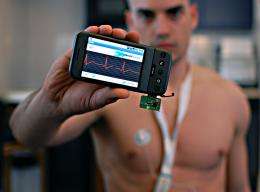ECG signals wirelessly transmitted to an Android mobile phone via a low-power interface.
Belgian Imec, together with TASS software professionals have developed a mobile heart monitoring system that allows to view your electrocardiogram on an Android mobile phone.
The innovation is a low-power interface that transmits signals from a wireless ECG (electrocardiogram or heart monitoring)-sensor system to an android mobile phone. With this interface, imec, Holst Centre and TASS are the first to demonstrate a complete Body Area Network (BAN) connected to a mobile phone enabling reliable long-term ambulatory monitoring of various health parameters such as cardiac performance (ECG), brain activity (EEG), muscle activity (EMG), etc. The system will be demonstrated at the Wireless Health Conference in San Diego (US, October 5-7).
The aging population, combined with the increasing need for care and the rising costs of healthcare has become a challenge for our society. Mobile health, which integrates mobile computing technologies with healthcare delivery systems, will play a crucial role in solving this problem by delivering a more comfortable, more efficient and more cost-efficient healthcare.
Body Area Networks (BAN) are an essential component of mHealth. BANs are miniaturized sensor networks; consisting of lightweight, ultra low-power, wireless sensor nodes which continuously monitor physical and vital parameters. They provide long-term monitoring, while maintaining user mobility and comfort. For example patients who are no longer compelled to stay in a hospital could be monitored at home.
The newly-developed low-power interface wirelessly transmits bio-signals retrieved by imec and Holst Centre’s Human++ BAN sensor nodes to an Android mobile phone where the data are collected, stored, processed, and sent over the internet to make them available for authorized users such as a physician. The interface is based on a standard Secure Digital Input Output (SDIO) interface on Android mobile phones, enabling the integration of all the features available on Google’s operating system (SMS, e-mail and data transmission over the internet, GPS to track user location).
Moreover, the mobile phone’s hardware is extended to operate with low-power communication protocols and low-power radios, enabling long-term medical telemonitoring. As the interface is based on the Linux kernel, the system is also easily portable on other Linux-based devices, such as PDA’s or laptops. And, the system allows configuration of thresholds on the measured parameters and automatic sending of alerts such as SMS messages and e-mails based on these values.
Source: IMEC






















